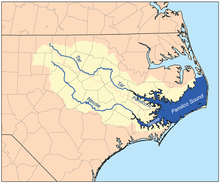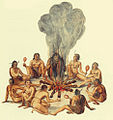The North Carolina PortalA view of
Harris Lake from the Harris Lake County Park in
Wake County, North Carolina, with the
Shearon Harris Nuclear Power Plant in view (2021)
 North Carolina ( /ˌkærəˈlaɪnə/ ⓘ KARR-ə-LIE-nə) is a state in the Southeastern region of the United States. It is bordered by Virginia to the north, the Atlantic Ocean to the east, South Carolina to the south, Georgia to the southwest, and Tennessee to the west. The state is the 28th-largest and 9th-most populous of the United States. Along with South Carolina, it makes up the Carolinas region of the East Coast. At the 2020 census, the state had a population of 10,439,388. Raleigh is the state's capital and Charlotte is its most populous city. The Charlotte metropolitan area, with an estimated population of 2,805,115 in 2023, is the most populous metropolitan area in North Carolina, the 22nd-most populous in the United States, and the largest banking center in the nation after New York City. The Research Triangle, with an estimated population of 2,368,947 in 2023, is the second-most populous combined metropolitan area in the state, 31st-most populous in the United States, and is home to the largest research park in the United States, Research Triangle Park. The earliest evidence of human occupation in North Carolina dates back 10,000 years, found at the Hardaway Site. North Carolina was inhabited by Carolina Algonquian, Iroquoian, and Siouan speaking tribes of Native Americans prior to the arrival of Europeans. King Charles II granted eight lord proprietors a colony they named Carolina after the king and which was established in 1670 with the first permanent settlement at Charles Town (Charleston). Because of the difficulty of governing the entire colony from Charles Town, the colony was eventually divided and North Carolina was established as a royal colony in 1729 and was one of the Thirteen Colonies. The Halifax Resolves resolution adopted by North Carolina on April 12, 1776, was the first formal call for independence from Great Britain among the American Colonies during the American Revolution. On November 21, 1789, North Carolina became the 12th state to ratify the United States Constitution. In the run-up to the American Civil War, North Carolina declared its secession from the Union on May 20, 1861, becoming the tenth of eleven states to join the Confederate States of America. Following the Civil War, the state was restored to the Union on July 4, 1868. On December 17, 1903, Orville and Wilbur Wright successfully piloted the world's first controlled, sustained flight of a powered, heavier-than-air aircraft at Kitty Hawk in North Carolina's Outer Banks. North Carolina often uses the slogan "First in Flight" on state license plates to commemorate this achievement, alongside a newer alternative design bearing the slogan "First in Freedom" in reference to the Mecklenburg Declaration and Halifax Resolves. ( Full article...) Entries here consist of
Good and
Featured articles, which meet a core set of high editorial standards.
Fort Dobbs was an 18th-century fort in the Yadkin–Pee Dee River Basin region of the Province of North Carolina, near what is now Statesville in Iredell County. Used for frontier defense during and after the French and Indian War, the fort was built to protect the American settlers of the western frontier of North Carolina, and served as a vital outpost for soldiers. Fort Dobbs' primary structure was a blockhouse with log walls, surrounded by a shallow ditch, and by 1759, a palisade. It was intended to provide protection from French-allied Native Americans such as the Shawnee raids into western North Carolina. The fort's name honored Arthur Dobbs, the Royal Governor of North Carolina from 1755 to 1765, who played a role in designing the fort and authorized its construction. Between 1756 and 1761, the fort was garrisoned by a variable number of soldiers, many of whom were sent to fight in Pennsylvania and the Ohio River Valley during the French and Indian War. On February 27, 1760, the fort was the site of an engagement between Cherokee warriors and Provincial soldiers that ended in a victory for the Provincials. ( Full article...)Selected article -
The
Neuse River (
/nuːs/
NOOSE, Tuscarora: Neyuherú·kęʔkì·nęʔ) is a river rising in the
Piedmont of
North Carolina and emptying into
Pamlico Sound below
New Bern. Its total length is approximately 275 miles (443 km), making it the longest river entirely contained in
North Carolina. The
Trent River joins the Neuse at New Bern. Its
drainage basin, measuring 5,630 square miles (14,600 km2) in area, also lies entirely inside North Carolina. It is formed by the confluence of the
Flat and
Eno rivers prior to entering the
Falls Lake reservoir in northern
Wake County. Its
fall line
shoals, known as the Falls of the Neuse, lie submerged under the waters of Falls Lake. This River also creates the beauty of the
Neuse River Trail, a 34.5 miles (55.5 km) long greenway that stretches from
Falls Lake Dam,
Raleigh, North Carolina to Legend Park,
Clayton, North Carolina. (
Full article...) General images -The following are images from various North Carolina-related articles on Wikipedia.
Did you know -
TopicsCategoriesNew articlesThis list was generated from
these rules. Questions and feedback
are always welcome! The search is being run daily with the most recent ~14 days of results. Note: Some articles may not be relevant to this project.
Rules | Match log | Results page (for watching) | Last updated: 2024-04-23 21:36 (UTC) Note: The list display can now be customized by each user. See List display personalization for details.
Related portalsWikiProjectsAssociated WikimediaThe following Wikimedia Foundation sister projects provide more on this subject:
Sources |


































